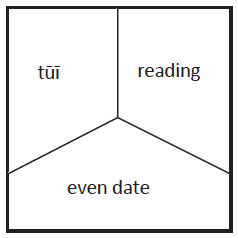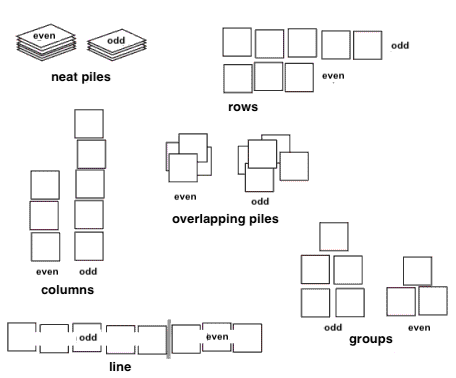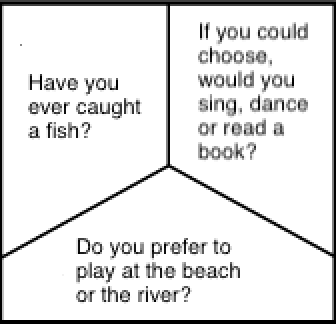This unit introduces the students to a way of looking at information from a group of individuals, i.e. a data set.
- Pose investigative questions.
- Write data collection or survey questions to support collecting information for investigation.
- Collect information.
- Sort information into categories.
- Display information to answer investigative questions or find out things.
- Answer investigative questions by sorting, organising and arranging information.
- Make sensible statements about the information and be able to back up their statements with appropriate displays.
A "data card" is simply a square piece of paper containing information about an individual person or thing. At this level, the data card is divided into three areas with the same category information in the same location on each card. In this unit, the terms data and information are used to mean the same thing and are interchanged throughout. Because several pieces of information about individuals are on each data card, different categories can be looked at simply by rearranging the cards.
This unit focuses on sorting and organising data sets, i.e. collections of information from a group of individuals. As the data set is looked at, questions or interesting things arise. This is different from starting with an investigative question then collecting data to answer the investigative question.
Understanding the difference between individual data and group data is central to the unit. The goal is to move students from “that is Jo’s data and that is me” to making statements about the group in general. Increasing students' ability to accurately describe aspects of a data set, including developing statistical vocabulary, is part of the unit. As students become comfortable with making statements and describing data, more precise vocabulary is to be encouraged. The meaning and usage of words like; same, similar, exactly and almost need to be explored during the unit along with the importance of using numerical descriptions, e.g. 2 more than, when describing or comparing data.
Investigative questions
At Level 2 students should be generating broad ideas to investigate and the teacher works with the students to refine their ideas into an investigative question that can be answered with data. Investigative summary questions are about the class or other whole group. The variables are categorical or whole numbers. Investigative questions are the questions we ask of the data.
The investigative question development is led by the teacher, and through questioning of the students, identifies the variable of interest and the group the investigative question is about. The teacher still forms the investigative question but with student input.
Data collection or survey questions
Data collection or survey questions are the questions we ask to collect the data to answer the investigative question. For example, if our investigative question was; “What native birds do the students in our class like?” a corresponding data collection or survey question might be “What is your favourite native bird?”
As with the investigative question, data collection or survey question development is led by the teacher, and through questioning of the students, suitable data collection or survey questions are developed.
The learning opportunities in this unit can be differentiated by providing or removing support to students and by varying the task requirements. Ways to support students include:
- encouraging category within category investigative questions
- allowing for additional data collection questions by dividing the data cards into four (or more) rather than three
- collecting data from another class and compare
- giving more ownership of the investigative question development, data collection and survey questions to the students.
The context for this unit can be adapted to suit the interests and experiences of your students. This can happen easily in Session 4 and 5.
The te reo Māori vocabulary term pātai (question) could be introduced in this unit and used throughout other mathematical learning.
pīwakawaka, tūī or kererū?
Session One
- Show the following data card to the class and explain what a data card is, i.e. a piece of paper contains three pieces of information about one person.

- Discuss the importance of knowing exactly what each piece of data is about.
What could “tūī” mean? What could “reading” mean? What could “Even date” mean? - Ask the class to tell you something about this student.
Does anyone in the class fit this data card?
Do you know someone that fits this data card that is not in this class?
How many different people could this data card be correct for? - Turn the data card over to reveal the name of someone familiar that fits this data card. The point to get across is that a data card could fit many people but each data card is about one person only.
- Explain to the students that the way to view each piece of data is to see it as the answer to a data collection or survey question/pātai. Get them to suggest the data collection questions that give these three pieces of information. Discuss how some students could answer the same data collection question differently, e.g. “What type of native bird do you like?” A more specific data collection question is needed, e.g. “What type of native bird do you like best- pīwakawaka, tūī or kererū?
What would a data card about you look like? - Hand out a data card to each student to fill out (Copymaster 2). Have each student write their name on the back of the data card hand and have a student collect these.
- After this session the teacher needs to arrange the data cards onto pieces of paper and photocopy them. One set is made for each pair of students. Photocopying onto coloured paper is suggested to make it easy to recognise the class data set. The names of the students on the back of the data cards are not needed. This data set will be used during Session Three.
Session Two
- Start the session by reminding the students about the data card they filled in during Session One. Select a data card one of the class filled out and read out the three pieces of data and ask the questions, “Whose data card could this one be?”, “Could it be anyone else in the class?”, “Could it be someone else in the school?”, “Could it be a teacher or other adult?” Repeat this several times.
- Organise the students into pairs and hand out to each pair a set of Data Set One, Copymaster 1. Tell them this is a group of students from another school and get them to cut out all the data cards. Once the data cards are cut out, have the students sort and organise the data cards to find out things about this data set. Remind them we are interested in the group and not individual students.
- At a suitable time, as the pairs of students are organising the data cards, have the class stop and look at the different ways the data cards have been arranged. Briefly discuss the different ways, along with writing up or drawing the different ways on to the board for all students to see. The question “What is good about this way?” or “When would it be good to organise the cards like this?” could be asked.

- Ask the following investigative questions and get each pair of students to organise the data cards into one of the above arrangements to show the answer.
- Which native bird do students in the class like the best - pīwakawaka, tūī or kererū? Organise into rows.
- What is the favourite subject in our class out of reading, writing and maths? Organise into columns.
- Do more students have odd or even birthdates? Arrange into groups.
- Have the students suggest similar investigative questions they could explore then encourage them to look at the data cards, organising and reorganising, to find out as much as they can about this group of students.
Initially encourage the students to look at one category at a time then, encourage students to look for categories within other categories, e.g. What favourite subject (reading, writing or maths) is most popular with students who like tūī? - Write on a large piece of paper what the class discovers or get each pair to write up what they find out about this group. Keep this information, as it can be used later to compare with other data sets.
Session Three
- Explain to the class that today they will be sorting and arranging data cards, like Session Two, except they will be using the data cards they wrote about themselves. Before the copied data cards are handed out, discuss what the students expect to find out.
What do you think we will find out about our class?
Will it be mainly different or similar to the group looked at in Session Two? - Hand out the copied data cards from Session One to each pair of students. The pairs are to cut out the data cards, sort them and organise them to look for other interesting things about the class.
- The teacher is to move around getting each pair to explain and show what they have found out. The teacher is to encourage the pairs to add detail to their answers, moving students from, “Yes, there are more students who like tūī than pīwakawaka or kererū.” to “Yes, there are 10 more students who like tūī compared to the total of 8 students who like pīwakawaka and kererū.”
- Conclude by considering the statements the students made at the start of the day and seeing how many were true and discussing other interesting things they found out about the class.
Session Four
Today the students, in pairs (tuakana/teina model could work well here), will design and collect their own data using data cards. Each pair of students needs to design three data collection questions to ask other students in the class.
- Discuss and brainstorm suitable data collection questions. Data collection questions for this activity need to be answered with either yes or no, or an option selected. Keep the optional answers to a maximum of three options.
Sample data collection questions:- What is your favourite kai - pizza or burgers?
- Have you ever caught a fish?
- If you could choose, would you sing, dance or read a book?
- Do you prefer to play at the beach or the river?
- Once suitable data collection questions have been developed they are to be written onto a large data card.

- Before starting to collect data each pair of students needs to write three investigative questions they could ask of the data they will collect and to make statements about what they expect to find out about the class for these investigative questions. Students should be encouraged to pose investigative questions about categories within categories, leading to statements about what they will find e.g. “People who like to read will select burgers as their favourite kai ” or “Most people surveyed will like kererū”.
- Each pair of students is to cut out enough blank data cards for the class and number them 1 to n (number in class). Once completed the pair of students are to ask half the students each, their three data collection questions and fill out a data card for each student. The student’s name needs to be written on the back to make sure all students are asked. They need to remember to complete their data cards for themselves as well.
Session Five
In pairs the students are to sort and organise their data cards to look for other interesting things about the class and to see if the statements they made about the class were correct.
After a set time each pair reports what they found out about the class. This could be in the form of a written report with some sentences about what they found out, a conference with their teacher or an oral presentation to the class.
Dear whānau,
At school we have been learning about data collection. You could support your child to write 3-4 questions to survey your whānau on. These questions should have a ‘yes’ or ‘no’ answer or 2-3 options for an answer. For example, What is your favourite native bird - kererū, tūī or pīwakawaka? Ask your child to say or write some concluding statements about the data s/he collects. For example, All the people in my whānau like tūī.